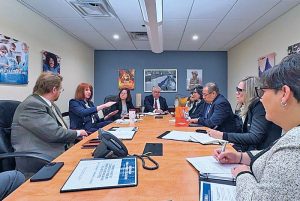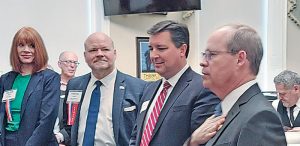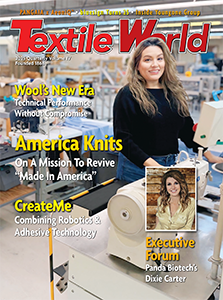
Trade Associations serve many roles, and recently the National Council of Textile Organizations (NCTO) seized the moment in a turbulent time for U.S. textiles.
TW Special Report
In the United States, trade associations play a noteworthy role in supporting industries, business and professionals through advocacy; providing a networking community; and presenting a unified, empowered group identity.
This is a tall order for any association, but even more so for those in textiles considering the depth and breadth of the segmented U.S. industry.
Recently, the National Council of Textile Organizations (NCTO) effectively seized the moment during a turbulent time, addressing a long-term international trade loophole affecting the industry and responding to fast-moving trade policy changes that carry significant weight on the survival and prosperity of U.S. textiles.
The National Council Of Textile Organizations
Trade associations have been an enduring feature of the U.S. textile industry throughout history, often with geographic or industry-sector focused missions.
Broad associations, that bridge sectors and geography, have been less prevalent and successful, but have a well-storied past that could fill volumes.
Today, NCTO’s identity stands in: “… representing the entire spectrum of the textile sector. From fibers to finished products, from machinery manufacturers to power suppliers, NCTO is the voice of the U.S. textile industry.”
It does so with five separate councils — Fiber; Yarn; Fabric; Finished Textile and Apparel; and Industry Support, which comprises distributors, converters, dyers, printers and finishers, as well as suppliers of products and services. Each council has a board for representation. This structure, according to the NCTO, is to “ensure a broad representation of the supply chain.”

De Mini — What?
Very few Americans including very few members of the textile industry, had ever heard the phrase “de minimis,” five years ago, let alone had any understanding of its implications on international trade or the health of U.S. textiles.
Today, the Latin phrase and its impact on the textile industry and consumers is well documented. Without getting in the weeds, the dictionary states, de minimis means “of minimal things” or “so small as to be disregarded.” In legal and business contexts, it refers to something insignificant or negligible, often to the point that it’s not worth addressing or taking legal action.
In terms of NCTO’s interest, the de minimis trade exemption was a customs accommodation for small packages, of little value — in this case $800 or less per day, per person — shipped internationally into the United States under Section 321 of the Tariff Act of 1930.
In short, an individual could receive a bottle of Scotch from an aunt living in Scotland at Christmas without clearing customs and paying duty.
Unfortunately, that accommodation became a loophole, then expanded to a loophole-based model for ecommerce giants and mass marketers.

De Minimis Impact
U.S. Customs and Border Protection (CBP) has a history of concern with de minimis shipments. “Both the volume and combined worth of low-value, or de minimis, shipments to the United States have risen significantly over the past ten years,” said then Secretary of Homeland Security Alejandro N. Mayorkas in a January 2025 press release. “The exemption of these goods from duties or taxes has under-mined American businesses and workers and flooded our ports of entry with foreign-made products, making CBP’s vital work screening these goods for security risks more difficult. The actions announced today to tighten this exemption will strengthen America’s economic and national security.”
The CBP press release also noted: “Over the last 10 years, the number of shipments entering the United States claiming the de minimis administrative exemption increased by more than 600 percent from approximately 139 million a year in Fiscal Year (FY) 2015, to over 1 billion a year by FY 2023. During Fiscal Year 2024, de minimis shipments rose once again to over 1.36 billion. This exponential increase has created challenges for CBP’s effective enforcement of U.S. trade laws, health and safety requirements, intellectual property rights, and consumer protection rules.”
Building A Coalition
An effective way for trade associations to successfully advocate is to band together with like-minded groups to amplify the message at hand and broaden its impact by raising awareness and motivating legislative change.
In March of 2024, “The Coalition to Close the De Minimis Loophole” was launched. NCTO President and CEO Kim Glas stated at the time: “De minimis is not just a textile issue — it’s an issue impacting us all — which is why this broad, diverse coalition has been formed to amplify our collective voices in the fight to get immediate, substantial and consequential change,” commending several congressional champions of closing the loophole, including then Congressman Earl Blumenauer [D-Ore.], Congressman Neal Dunn [R-Fla.], Congresswoman Rosa DeLauro [D-Conn.], and then Congressman Dan Bishop [R-N.C].
Glas added: “Closing this loop-hole will simultaneously assist law enforcement battle the deadly fentanyl and broader illicit drug crisis while also assisting U.S. businesses to operate on a more level playing field with competitors overseas. We urge others in Congress and the Administration to support the effort and immediately close de minimis.”
By broadening the scope of support and illuminating the loophole’s impact, some 29 interested associations and organizations are now behind the issue and advocating for reform.
Diverse groups including the American Federation of Labor and Congress of Industrial Organizations (AFL-CIO), National Association of Police Organizations, Families Against Fentanyl the Coalition for a Prosperous America, and even the United Steelworkers came together and made their voices heard.
A Significant Result
After much testimony and legislative processes, the most current activity on de minimis, as of TW’s press time, was House passage of a budget reconciliation package which includes a provision that would permanently end de minimis for commercial shipments from all countries by July 2027. The legislation next goes to the Senate, and NCTO and the coalition are pressing to keep the provision in the broader budget and tax bill.
Recently, U.S. Senators Sheldon Whitehouse (D-R.I.) and Lindsey Graham (R-S.C.) introduced another strong proposal, the Closing the De Minimis Loophole Act.
Glas commended the Senators “… for their leadership and support of this important bipartisan legislation that would codify and permanently end de minimis treatment for China immediately, while phasing out de minimis for all other countries after a four-month transition period. This bill, a companion to legislation in the House, is the strongest and most comprehensive legislative solution to closing the destructive de minimis loophole once and for all. … The legislation will help level the playing field for the domestic textile industry, which has lost 28 textile plants over the past 22 months. We strongly sup-port this legislation and look forward to working with Senators White-house and Graham to advance it.”
Prior to the introduction of the act, President Donald J. Trump signed an Executive Order eliminating duty-free de minimis treatment for low-value imports from China and Hong Kong. While that order currently stands, it is in limbo and caught up in court cases challenging President Trump’s executive order and authority to impose broad-based tariffs on countries.
It is important to note that this order targets de minimis packages from China and Hong Kong which are packages utilizing the $800 loop-hole most often.

Trade Earthquake
At the 21st NCTO annual meeting held in Washington, Glas shared with the gathered attendees an account of the quick, effective engagement of the NCTO and key members to address a pending crisis that would cancel the United States-Mexico-Canada Agreement (USMCA) and, in her words, “lose half the industry overnight.”
Glas said: “There are certain industry leaders who are not in this room right now because they are writing a letter [to a Cabinet official who] asked our industry to write immediately to put on President Trump’s desk this afternoon.
“We had an urgent meeting with [the high-level administration official] this morning at 11 a.m. at the start of our annual meeting asking him to do everything possible to help our industry grow. Qualified trade, penalties to our Western Hemisphere are all on the line for our industry where we can literally lose 70 percent of our export market, which would hurt even our domestic manufacturers who have fully verticalized supply chain.
As she characterized the events, Glas said: “This is the velocity with which decision making is happening in Washington now. I urge all of you, if you don’t know your member of congress, make sure they get to know you, they come out to your plant. Congressman Hudson was in that meeting with us, from North Carolina, and it made all the difference.”

Glas also described a key meeting the prior day saying: “Yesterday, we had a meeting … and I’m sorry if I’m fired up, I’ve had 12 cups of coffee … but yesterday we were in the West Wing. And when you go to the West Wing, the aura of that just falls on you. It’s like no other place to have a meeting. You are sitting in the West Wing and the situation room is right down the hall … here we are.
“And people say we’re the little old textile industry. We’re not the little old textile industry, we’re the mighty textile industry and we deserve to be in the West Wing.
“I’m going to tell you those CEOs who were in that room carried the weight of all of you in this room, and the people not in this meeting today. It wasn’t about their individual company; it was about the textile team on the field and getting the yards we need to get a goal and to help prevent the worst losses imaginable.”
Situational awareness, being prepared for quick, effective engagement, and successfully making your associations’ case at a critical moment are all hallmarks of a trade association fulfilling its noteworthy role.
As Glas continued addressing industry leaders during the annual meeting, she said, “You’re carrying your team, meaning your workers at your facility, just as much as those CEOs were carrying the textile team, the entirety of it, in these meetings the last couple of days. So, in this period of time, we need to be more collaborative, more thoughtful, we need to let out our stress. We need to show appreciation for where we came from and where we are today.”
Regarding engagement Glas said, “It is the greatest honor for all of us to represent you. We are in this fight with you. But it takes all of us, including our CEO leaders. It’s one thing for me and others here on this stage to talk to congressional offices. It’s a totally different ball of wax because you are representing your facilities and are doing the work. You inspire us, and so I want to say my deep appreciation. And I also want to deeply thank the NCTO team. This has been an incredibly busy five years. This has been an incredibly busy five weeks!”
Results
As of TW’s press time, goods qualifying under the USMCA remain in force. USMCA-compliant imports from Mexico and Canada continue to enter the United States without tariffs, which is critical for the U.S. textile industry. Non-USMCA-compliant textiles from Mexico and Canada face a 25 percent tariff, incentivizing the use of U.S. manufactured components.
Regarding the Administration’s actions, Glas said: “The U.S. textile industry ships $12.3 billion, or 53 percent, of its total global textile exports to Mexico and Canada and those component materials often come back as finished products to the United States under the USMCA. It is by far the largest export region for American textile producers, representing $20 billion in two-way trade that spurs enormous textile investment and employment in the United States. Preserving duty free, qualified trade is absolutely critical to the U.S. textile industry and will provide incentives for more companies to onshore even greater production capacity, giving a boost to American textile manufacturers and their workers.”
A Trade Association In Action
Trade associations come in all shapes, sizes and flavors. But, in this moment, and with its long road to solve the de minimis loophole, the NCTO has largely fulfilled a note-worthy role in supporting the U.S. textile industry — its businesses and plants — through effective advocacy; providing a community and network; and presenting a unified, empowered group identity.
It bears repeating what Glas said. “We’re not the little old textile industry, we’re the mighty textile industry and we deserve to be in the West Wing.”
2025 Quarterly Issue II




